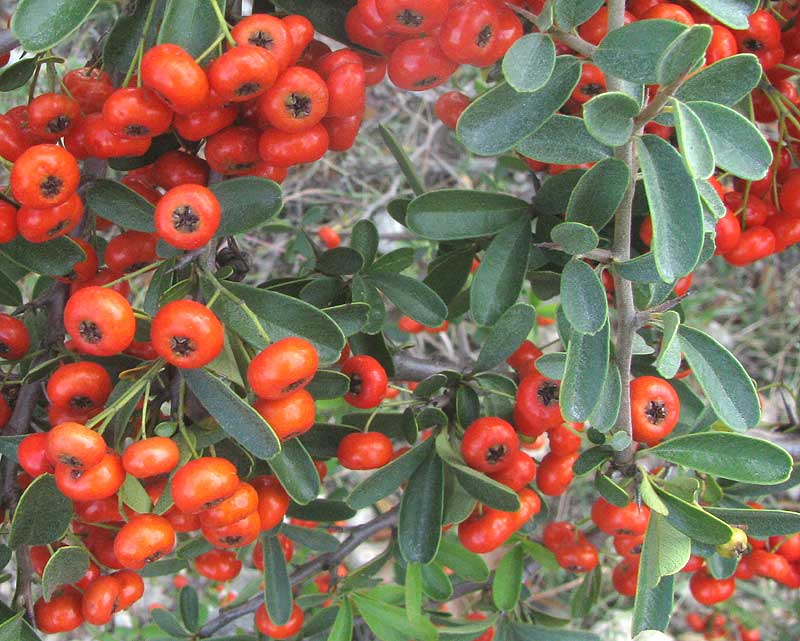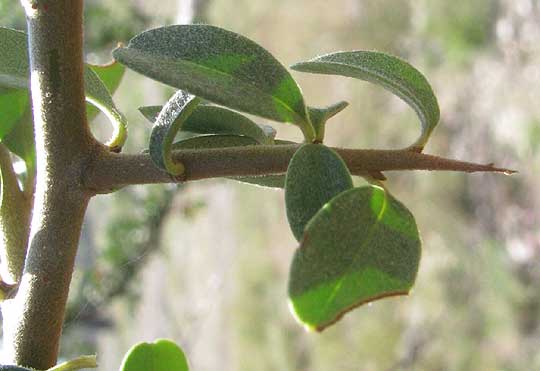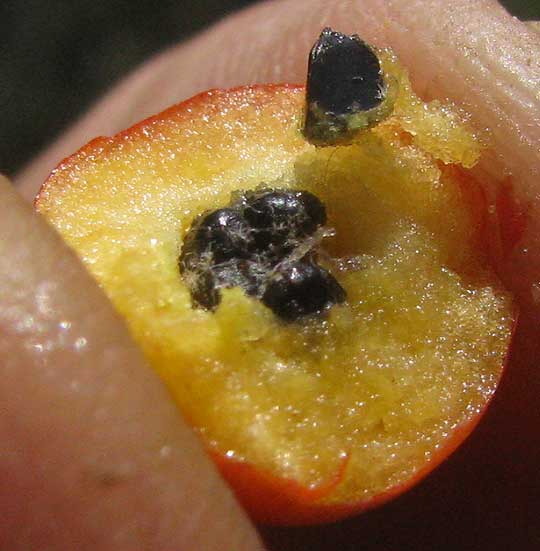Excerpts from Jim Conrad's
Naturalist Newsletter

from the the October 28, 2012 Newsletter issued from the valley of the Dry Frio River in northern Uvalde County, southwestern Texas, on the southern border of the Edwards Plateau; elevation ~1750m (~5750 ft); N29.62°, W99.86°; USA
EATING PYRACANTHA FRUITS
On a cobblestone and gravel bar in the floodplain of the little Dry Frio River running behind the cabin there's a small ornamental tree whose origins are long forgotten, or never known. These days it's resplendent with heavy clusters of pea-sized, orangish-red fruits, as shown above.
You'll probably recognize these as pyracantha fruits, since pyracanthas are very commonly planted in cities, often between sidewalks and the bases of buildings, where their bright fall and winter fruits add color to the landscape. About seven species of pyracantha are recognized, all native to an area extending from Southeastern Europe to Southeastern Asia. Our Dry Frio species easily is distinguished from other planted species by the dense, grayish hairiness of its leaves and stems, and by the narrowness and bluntness of its leaves. It's the Narrowleaf Firethorn or Narrowleaf Pyracantha, PYRACANTHA ANGUSTIFOLIA, native to southwestern China.
Pyracanthas as a group generally are somewhat thorny, as is ours. Narrowleaf Firethorn's thorns are worth noticing, for they display an intermediate evolutionary stage between a stem and a regular thorn. They bear leaves as if they were stems, but they're definitely sharp-pointed, as you can see below:

My Estonian lady-friend Malle, who is living with me in the cabin beside the Dry Frio, sometimes comes up with some surprising ideas. One of them was uttered when she saw our Narrowleaf Firethorn so heavy with fruits. "Those are good to eat," she said.
I was sure I'd read that pyracantha fruits are inedible, maybe even poisonous, and certainly when I've tasted the fruits of other pyracantha species in years past I wasn't impressed. However, this time, mostly to humor Malle, I nibbled on one, and found that it had a fair amount of pleasant tasting flesh surrounding five tiny, crunchy, black seeds. You can see a fruit with a dislodged seed below:

So, we picked a hatful and later that day enjoyed a dish of mashed-together potatoes, carrots, celery and pyracantha fruits. It was delicious, though the tiny, hard seeds made for a slightly disconcerting crunchiness. Malle, who watches what she eats, glowed with the notion that she'd found such a convenient local source of nutritional carotene.
In fact, on the Internet I found a published study asserting that the ripe fruit of Pyracantha angustifolia "... constitutes the only practical source of pro-gamma-carotene at the present time."
However, the current Wikipedia page for Pyracantha angustifolia unequivocally states that the fruits of Narrowleaf Firethorn are "astringent and bitter, making them inedible for humans, but they are a food source for birds. The leaves, fruit and seeds contain hydrogen cyanide, the source of the bitter taste."
Later we realized that Malle had confused the pyracantha with another tree, one called Astelpaju in Estonian, so Estonians do not habitually eat pyracantha fruits. However, now we do know that our Narrowleaf Pyracantha's fruits taste pretty good, have lots of carotene in them, and after you eat a handful of them you still feel pretty good!